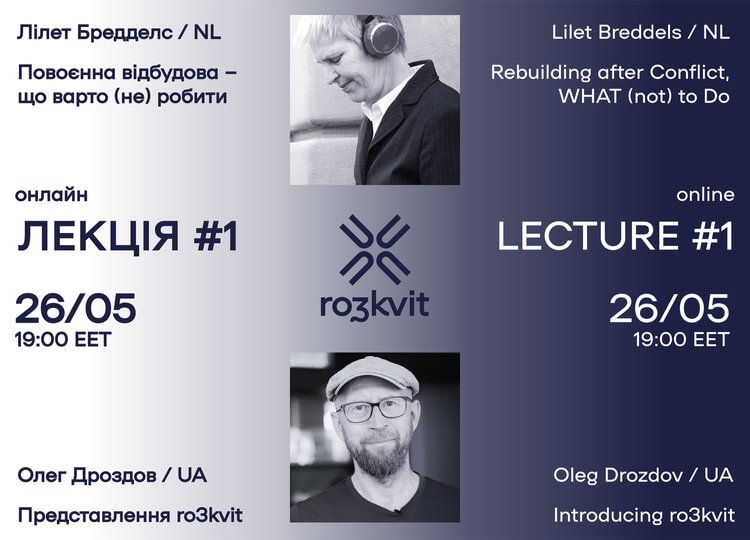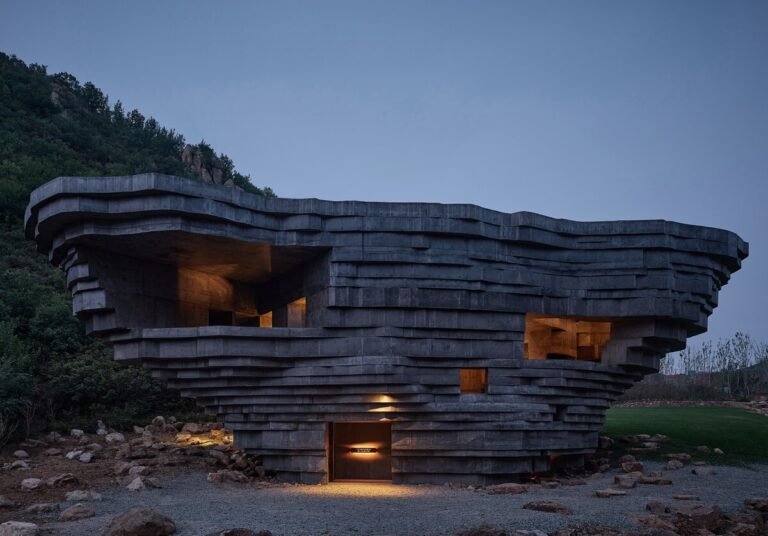Conversations on Architecture, a new book by Ukrainian architects launched in a Lviv bomb shelter
After five years in the making, the book Conversation on Architecture by Ukrainian architects Oleg Drozdov and Bohdan Volynskyi was set to hit the shelves in late February this year. Then their country was invaded.
The book was eventually published two months later, debuting on April 28, 2022, at the Lviv National Academy of Arts. Five minutes into the event, air-raid sirens sounded. Attendees packed into a bomb shelter, a dingy underground space that could only fit about one third of the initial 150-person crowd, and the talk continued.
That conversation, led by Volynskyi and Drozdov, began by addressing what was on everyone’s minds: the on-going war. As Russian forces continue their attack on Ukraine, destroying cities, landmarks, and homes, many Ukrainian architects found themselves confronted with a torrent of unprecedented challenges: For one, there was the question of how to shelter the millions of displaced Ukrainians.
By early April, Drozdov’s firm, Drozdov&Partners, helped set up temporary shelters in fourteen refugee centers in western parts of Ukraine, working with London-based architecture firm Replus Bureau and Kharkiv-based architecture firm Ponomarenko Bureau. The design of the eight-cubic-meter temporary shelters was adapted from Japanese architect Shigeru Ban’s modular paper tube frameworks.

The war also prompted architects to reconsider the criteria for a safe city, a topic also discussed during the book launch. The Soviet-era metro stations, where many Ukrainians in eastern cities sought refuge from Russian bombardment, turned out to be a miracle, Drozdov told AN.
Then there was also the more long-term question of how Ukraine’s war-torn cities would be rebuilt. Volynskyi walked the group through several potential solutions drafted by architects, including one by British architect Norman Foster, who met with Kharkiv Mayor Ihor Terekov and prepared a manifesto promising to bring ”the city of the future to Kharkiv.” Foster’s proposal received a lukewarm response from Ukrainian architects, at best.
Drozdov has assembled his own team of best minds to respond to rebuilding: Ro3kvit (pronounced “rozkvit”), is an urban planning coalition co-founded by Drozdov and Dutch architect and urbanist Fulco Treffers to tackle the many issues that have arisen as a result of the war– the urgent, the long term, the local, and the national. So far, the coalition comprises an impressive roster of 24 architects, historians, urbanists, both from Ukraine and international destinations. Ro3kvit aims to develop sustainable building strategies, both short-term and long-term, that meet local needs in Ukraine. The coalition plans to host a public lecture series over the next few weeks, which can be attended via zoom every other Thursday night (or at 12 p.m. ET). Simultaneous translations in both English and Ukrainian will be provided by Olena Nefyodova. Attendees will also be able to ask questions in a live Q&A at the end of each lecture.
“We understand that rebuilding means rebuilding of life,” Drozdov said in an introductory address at the coalition’s first virtual public lecture, “it’s not only about physical rebuilding.”
Drozdov and Volynskyi were well aware that the rebuilding of Ukraine would be a task involving a plethora of considerations, each of which had to be weighed carefully. Throughout the conversation, they raised the questions that architects will have to perpetually ask themselves when it finally comes time to rebuild: How can architects maintain Ukraine’s national identity during reconstruction? What shapes Ukrainian architecture? How can architects defend the right to urban space?
In writing Conversations on Architecture, Drozdov and Volynskyi had already begun answering some of these questions. For the two Ukrainian architects, meeting the needs of a nation whose statehood was under threat was, in a way, nothing new. They crossed paths during the wintry months of late 2013 and early 2014 during Euromaidan, the last major episode of Russian aggression in which alleged pressure from the Kremlin caused former Ukrainian President Viktor Yanukovych to withdraw from signing an association agreement with the European Union, sparking intense protests in Ukraine. (Russia’s annexation of Crimea followed soon after.)

The wave of widespread civil unrest prompted Drozdov and Volynskyi to steer their practices toward “activist architecture,” Volynskyi explained to AN. The duo’s new book has a chapter on social responsibility in architecture, in which Drozdov and Volynskyi acknowledge that “the complex structures of human relationships will be reflected in buildings.”
After this shift, Volynskyi and Drozdov turned their attention toward architectural education, recognizing that training young architects plays an important role in the future of Ukrainian architecture. Volynskyi—who previously founded dash!, an architectural school for children and teens—helped Drozdov found the Kharkiv School of Architecture in 2015.
While the two were working to launch the architecture school, Volynskyi pitched the idea for Conversations on Architecture to Drozdov. At the time, Drozdov’s twenty-year-old practice had yet to be documented in a book—Conversations on Architecture is the first to do so.
Periodically over five years, the two would sit down, turn on a recording device, and discuss various topics, including the use of light, climate, and an architect’s social responsibility; these topics became the chapters of the book. The two architects take readers through the gardens, neighborhoods, markets, and streets of Ukraine, with Drozdov as the primary narrator and Volynskyi’s secondary contributions in italics. The latter’s footnotes also lend insight into how the book was put together, as Volynskyi was primarily responsible for turning the collection of recorded conversations into a manuscript.
The book was the first title produced in Ukraine by ist publishing during the war in late March, a triumph that could be credited to the publishing company’s courageous staff, who printed and sewed 1,500 copies of the book in Kyiv. “For me, to get paper copies was something fantastic and unreal. Something from another life,” Kateryna Nosko, of ist publishing, said. At the start of the war, Nosko was only able to bring a small backpack of work documents with her when she escaped from Kyiv to western Ukraine. ist publishing has come a long way since the start of the war: They’re now able to ship Conversations on Architecture worldwide. Drozdov hopes that Conversations on Architecture will aid architects as they face challenges that have arisen due to the war.
“Today, we’re all acting in an emergency,” Volynskyi told AN.

